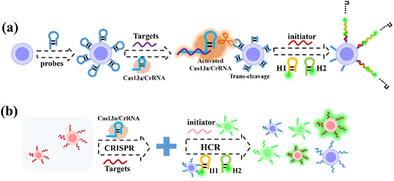CRISPR/ cas13a增强多孔水凝胶封装光子条形码用于多路病毒检测
IF 13
2区 材料科学
Q1 CHEMISTRY, MULTIDISCIPLINARY
引用次数: 0
摘要
在本研究中,我们利用CRISPR/Cas13a技术结合结合杂交链反应(HCR)的水凝胶封装光子晶体(PhC)条形码,提出了一种对SARS-CoV-2和流感(Flu)的超灵敏特异性多重检测方法。以核壳结构为特征的条形码是通过周期性有序的六边形紧密堆积的二氧化硅珠的部分复制而制成的。因此,这些条形码的蛋白石水凝胶外壳具有丰富的相互连接的孔隙,为探针固定提供了大量的表面积。此外,由于条形码核心的强大机械强度,在检测事件中固有的结构颜色保持稳定。CRISPR/Cas13a和HCR的整合利用了Cas13a的高特异性RNA识别能力和反式切割活性,同时利用HCR来提高灵敏度。当遇到靶RNA时,Cas13a切割一个发夹探针,从而启动后续的HCR扩增以提高检测灵敏度。该方法对SARS-CoV-2、甲型流感和乙型流感RNA的多重检测具有较高的准确性和灵敏度,检测限低至200 aM。重要的是,该分析在重复的临床样品测试中也显示出可接受的准确性。因此,我们的平台代表了临床高灵敏度多路病毒检测的一个有希望的策略。本文章由计算机程序翻译,如有差异,请以英文原文为准。

CRISPR/Cas13a-Enhanced Porous Hydrogel Encapsulated Photonic Barcodes for Multiplexed Detection of Virus
In this study, we present an ultrasensitive and specific multiplexed detection method for SARS-CoV-2 and influenza (Flu) utilizing CRISPR/Cas13a technology combined with a hydrogel-encapsulated photonic crystal (PhC) barcode integrated with hybridization chain reaction (HCR). The barcodes, characterized by core-shell structures, are fabricated through partial replication of periodically ordered hexagonally close-packed silicon dioxide beads. Consequently, the opal hydrogel shell of these barcodes features abundant interconnected pores that provide a substantial surface area for probe immobilization. Furthermore, the inherent structural colors remain stable during detection events due to the robust mechanical strength of the barcode cores. This integration of CRISPR/Cas13a and HCR leverages both the highly specific RNA recognition capabilities and trans-cleavage activity of Cas13a while employing HCR to enhance sensitivity. Upon encountering target RNA, Cas13a cleaves a hairpin probe, thereby initiating subsequent HCR amplification for enhanced detection sensitivity. Our method demonstrates high accuracy and sensitivity in multiplexed detection of SARS-CoV-2, Flu A and Flu B RNA with a limit-of-detection as low as 200 aM. Importantly, this assay also exhibits acceptable accuracy in repeated clinical sample testing. Thus, our platform represents a promising strategy for highly sensitive multiplexed virus detection in clinical.
求助全文
通过发布文献求助,成功后即可免费获取论文全文。
去求助
来源期刊

Small
工程技术-材料科学:综合
CiteScore
17.70
自引率
3.80%
发文量
1830
审稿时长
2.1 months
期刊介绍:
Small serves as an exceptional platform for both experimental and theoretical studies in fundamental and applied interdisciplinary research at the nano- and microscale. The journal offers a compelling mix of peer-reviewed Research Articles, Reviews, Perspectives, and Comments.
With a remarkable 2022 Journal Impact Factor of 13.3 (Journal Citation Reports from Clarivate Analytics, 2023), Small remains among the top multidisciplinary journals, covering a wide range of topics at the interface of materials science, chemistry, physics, engineering, medicine, and biology.
Small's readership includes biochemists, biologists, biomedical scientists, chemists, engineers, information technologists, materials scientists, physicists, and theoreticians alike.
 求助内容:
求助内容: 应助结果提醒方式:
应助结果提醒方式:


